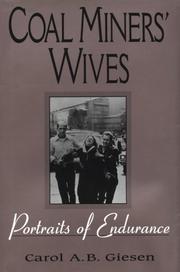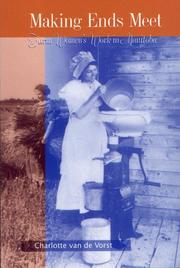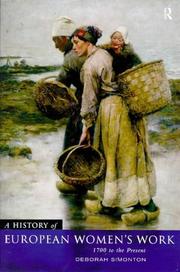| Listing 1 - 9 of 9 |
Sort by
|

ISBN: 0813108454 0813157145 9780813157146 1322596891 9781322596891 0813119030 9780813119038 0813189489 Year: 2015 Publisher: Lexington The University Press of Kentucky
Abstract | Keywords | Export | Availability | Bookmark
 Loading...
Loading...Choose an application
- Reference Manager
- EndNote
- RefWorks (Direct export to RefWorks)
Few people in America today live with the dangers and deprivations that Appalachian coal mining families experience. But to the eighteen West Virginia women Carol Giesen interviewed for this book, hard times are just everyday life.These coal miners' wives, ranging in age from late teens to eighty-five, tell of a way of life dominated by coal mining -- and shadowed by a constant fear of death or injury to a loved one. From birth to old age, they experience the social and economic pressures of the coal mining industry. Few families in these communities earn their living in any job outside a coal
Women --- Coal miners' spouses --- Human females --- Wimmin --- Woman --- Womon --- Womyn --- Females --- Human beings --- Femininity --- Coal miners' wives --- Miners' spouses --- Social conditions. --- Social conditions --- E-books
Book
Abstract | Keywords | Export | Availability | Bookmark
 Loading...
Loading...Choose an application
- Reference Manager
- EndNote
- RefWorks (Direct export to RefWorks)
May 2000 - Some aspects of violent behavior are linked to economic incentives and deserve more attention from economists. In India, for example, domestic violence is used as a bargaining instrument, to extract larger dowries from a wife's family, after the marriage has taken place. Bloch and Rao examine how domestic violence may be used as a bargaining instrument, to extract larger dowries from a spouse's family. The phrase dowry violence refers not to the dowry paid at the time of the wedding, but to additional payments demanded by the groom's family after the marriage. The additional dowry is often paid to stop the husband from systematically beating the wife. Bloch and Rao base their case study of three villages in southern India on qualitative and survey data. Based on the ethnographic evidence, they develop a noncooper-ative bargaining and signaling model of dowries and domestic violence. They test the predictions from those models on survey data. They find that women whose families pay smaller dowries suffer increased risk of marital violence. So do women who come from richer families (from whom resources can more easily be extracted). Larger dowries - as well as greater satisfaction with the marriage (in the form of more male children) - reduce the probability of violence. In India marriage is almost never a matter of choice for women, but is driven almost entirely by social norms and parental preferences. Providing opportunities for women outside of marriage and the marriage market would significantly improve their well-being by allowing them to leave an abusive husband, or find a way of bribing him to stop the abuse, or present a credible threat, which has the same effect. This paper - a product of Poverty and Human Resources, Development Research Group - is part of a larger effort in the group to examine crime and violence in developing countries. Vijayendra Rao may be contacted at vrao@worldbank.org.
Adolescent Health --- Benef Children --- Divorce --- Domestic Violence --- Families --- Family --- Females --- Gender --- Gender and Law --- Health, Nutrition and Population --- Home --- House --- Husband --- Husbands --- Law and Development --- Marriage --- Marriages --- Sanctions --- Social Development --- Social Inclusion and Institutions --- Wedding --- Wife --- Will --- Wives --- Woman --- Women
Book
Year: 2007 Publisher: Washington, D.C., The World Bank,
Abstract | Keywords | Export | Availability | Bookmark
 Loading...
Loading...Choose an application
- Reference Manager
- EndNote
- RefWorks (Direct export to RefWorks)
In a setting where husbands wield considerable coercive power, forms of marriage should adapt to protect the interests of women and their families. The authors study the pervasive marriage custom of watta satta in rural Pakistan, a bride exchange between families coupled with a mutual threat of retaliation. They show that watta satta may be a mechanism to coordinate the actions of two sets of in-laws, each of whom wish to restrain their sons-in-law but who only have the ability to restrain their sons. The authors' empirical results support this view. The likelihood of marital inefficiency, as measured by estrangement, domestic abuse, and wife's mental health, is significantly lower in watta satta arrangements as compared with conventional marriages, but only after properly accounting for selection.
Anthropology --- Child --- Culture & Development --- Divorce --- Domestic Abuse --- Domestic Violence --- Families --- Family --- Female --- Gender --- Gender and Law --- Health, Nutrition and Population --- Home --- Husband --- Husbands --- Law --- Law and Development --- Laws --- Marriage --- Marriages --- Population and Development --- Population Policies --- Residence --- Social Development --- Social Inclusion and Institutions --- Wife --- Will --- Wives --- Woman --- Women

ISBN: 1283090880 9786613090881 0887553400 9780887553400 0887556671 9780887556678 9781283090889 Year: 2002 Publisher: Winnipeg, Manitoba : University of Manitoba Press,
Abstract | Keywords | Export | Availability | Bookmark
 Loading...
Loading...Choose an application
- Reference Manager
- EndNote
- RefWorks (Direct export to RefWorks)
Based on hundreds of interviews with Manitoba farm men and women, Making Ends Meet reconstructs the common history shared by modern farm women as well as by their mothers and grandmothers. It explores women's changing roles on the farm, from the early days of the Red River settlement to the twentieth-century farm community. The women's own stories reveal their ingenuity and tenacity in "making ends meet" through economies, shared, labour, and generation of new resource income as varied as raising poultry and custom woodworking. These stories prove that the contributions of farm women have been vital in establishing and maintaining the family farm, and are critical to its continued survival.
Family farms --- Farms --- Farms, Small --- Private plot agriculture --- Economic aspects --- History. --- Women in agriculture --- Rural women --- Farmers' spouses --- Agriculture --- Sexual division of labor --- Division of labor by sex --- Division of labor --- Sex role --- Sex discrimination in employment --- Farming --- Husbandry --- Industrial arts --- Life sciences --- Food supply --- Land use, Rural --- Farmers' wives --- Spouses --- Women --- Farm women --- History --- Employment&delete& --- Social conditions --- Economic aspects&delete& --- E-books --- Employment
Book
ISBN: 1462306691 145271195X 1281155403 9786613776761 1451891687 Year: 2004 Publisher: Washington, D.C. : International Monetary Fund,
Abstract | Keywords | Export | Availability | Bookmark
 Loading...
Loading...Choose an application
- Reference Manager
- EndNote
- RefWorks (Direct export to RefWorks)
This paper theoretically and empirically investigates the role of spousal labor in buffering transitory shocks to husbands' earnings. To measure the amount of the shock that spousal labor absorbs, an instrumented cross-sectional variance decomposition is developed. Using data from the Panel Study of Income Dynamics, the paper finds that the smoothing resulting from the wives' labor response (both labor force participation and hours of work) is larger for households with limited access to credit. This finding, which is consistent with the model's prediction, indicates that because of the presence of liquidity constraints, the temporal change in family income (exclusive of wives' earnings) reinforces the substitution effect in explaining the effect of shocks to the husbands' earnings on spousal labor.
Married women --- Women --- Liquidity (Economics) --- Assets, Frozen --- Frozen assets --- Finance --- Human females --- Wimmin --- Woman --- Womon --- Womyn --- Females --- Human beings --- Femininity --- Married people --- Wives --- Employment --- Economic aspects --- Econometric models. --- Labor --- Macroeconomics --- Money and Monetary Policy --- Wages, Compensation, and Labor Costs: General --- Labor Economics: General --- Aggregate Factor Income Distribution --- Monetary Policy, Central Banking, and the Supply of Money and Credit: General --- Demand and Supply of Labor: General --- Labour --- income economics --- Monetary economics --- Wages --- Income --- Credit --- Labor supply --- Labor economics --- Labor market --- United States --- Income economics

ISBN: 0791401073 0585077274 9780585077277 0791499553 9780791499559 Year: 1990 Publisher: Albany State University of New York Press
Abstract | Keywords | Export | Availability | Bookmark
 Loading...
Loading...Choose an application
- Reference Manager
- EndNote
- RefWorks (Direct export to RefWorks)
Household employees. --- Housewives. --- Subsistence economy. --- Women --- Employment. --- Employment of women --- Domestic employees --- Domestics --- Household staff --- Household workers --- Servants --- Occupations --- Equal pay for equal work --- Sex discrimination in employment --- Working women in motion pictures --- Cost and standard of living --- Economic anthropology --- Poverty --- Homemakers --- Mothers --- Wives --- Domestic service employees --- Domestic service workers --- Service employees, Domestic --- Service workers, Domestic --- Employees --- Household employees --- Housewives --- Informal sector (Economics) --- Subsistence economy --- Hidden economy --- Parallel economy --- Second economy --- Shadow economy --- Subterranean economy --- Underground economy --- Artisans --- Economics --- Small business --- Employment --- E-books
Book
ISBN: 9783034300568 3034300565 Year: 2009 Publisher: Bern: Peter Lang,
Abstract | Keywords | Export | Availability | Bookmark
 Loading...
Loading...Choose an application
- Reference Manager
- EndNote
- RefWorks (Direct export to RefWorks)
What does well-being mean when we talk about men and women in the past? Their sheer chances of survival, their protection from want, their social status, their individual agency and their self-esteem were all strongly mediated by the family, the predominant social institution. Family laws and customs of family formation created differences between insiders and outsiders in terms of well-being. Within families, there were strong differences in autonomy, status and freedom between the genders and generations. The book offers a fascinating exploration of gender differences in well-being in many regions of historic Europe, with some comparative perspectives. It explores how historic family systems differed with respect to choosing a marriage partner, transmitting property, living and care conditions of widows and widowers and the position of children born out of wedlock.
Marriage --- Inheritance and succession --- Domestic relations --- Married women --- Mariage --- Successions et héritages --- Familles --- Femmes mariées --- Economic aspects --- History. --- Social aspects --- Social conditions. --- Aspect économique --- Histoire --- Droit --- Conditions sociales --- History --- Social conditions --- EUR / Europe - Europa --- 331.100 --- 331.20 --- 311.95 --- 172 --- Economische geschiedenis: algemeenheden. --- Sociale geschiedenis: algemeenheden. --- Bevolking naar het geslacht. --- Gezinsmoraal. Huwelijk. Echtscheiding. --- Successions et héritages --- Femmes mariées --- Aspect économique --- Married people --- Women --- Wives --- Married life --- Matrimony --- Nuptiality --- Wedlock --- Love --- Sacraments --- Betrothal --- Courtship --- Families --- Home --- Honeymoons --- Bequests --- Descent and distribution --- Descents --- Hereditary succession --- Intestacy --- Intestate succession --- Law of succession --- Succession, Intestate --- Real property --- Universal succession --- Trusts and trustees --- Family law --- Persons (Law) --- Sex and law --- Social aspects&delete& --- Economic aspects&delete& --- Gezinsmoraal. Huwelijk. Echtscheiding --- Bevolking naar het geslacht --- Economische geschiedenis: algemeenheden --- Sociale geschiedenis: algemeenheden --- Law and legislation --- Marriage - Economic aspects - Europe - History --- Inheritance and succession - Social aspects - Europe - History --- Domestic relations - Europe - History --- Married women - Europe - Social conditions --- Famille --- Aspects économiques --- Europe --- Aspects sociaux

ISBN: 0415055326 0415055318 1280185007 1134936788 020300700X 9780203007006 9780415055314 9780415055321 0203199804 9780203199800 9781280185007 9786610185009 661018500X 9781134936786 9781134936779 113493677X 9781134936731 Year: 1998 Publisher: London New York Routledge
Abstract | Keywords | Export | Availability | Bookmark
 Loading...
Loading...Choose an application
- Reference Manager
- EndNote
- RefWorks (Direct export to RefWorks)
The work patterns of European women from 1700 onwards fluctuate in relation to ideological, demographic, economic and familial changes. In A History of European Women's Work, Deborah Simonton draws together recent research and methodological developments to take an overview of trends in women's work across Europe from the so-called pre-industrial period to the present.Taking the role of gender and class in defining women's labour as a central theme, Deborah Simonton compares and contrasts the pace of change between European countries, distinguishing between Europe-wide issues and
History of Europe --- anno 1700-1799 --- anno 1800-1899 --- Women --- Rural women --- Women household employees --- Women farmers --- Housewives --- Home economics --- Femmes --- Femmes rurales --- Employées de maison --- Agricultrices --- Maîtresses de maison --- Economie domestique --- Employment --- History --- Travail --- Histoire --- #SBIB:316.346H22 --- #SBIB:316.356.2H1510 --- #SBIB:316.356.2H1540 --- #SBIB:93H3 --- #SBIB:AANKOOP --- Positie van de vrouw in de samenleving: arbeid en beroep --- Gezin en huishoudelijk werk --- Gezin en buitenhuisarbeid van de vrouw: algemeen --- Thematische geschiedenis --- History. --- Employées de maison --- Maîtresses de maison --- Domestic economy --- Domestic science --- Family and consumer sciences --- Household management --- Household science --- Women as farmers --- Housemaids --- Maids, House --- Women domestics --- Women servants --- Human females --- Wimmin --- Woman --- Womon --- Womyn --- Europe --- Females --- Human beings --- Femininity --- Household employees --- Farmers --- Women in agriculture --- Homemakers --- Mothers --- Wives --- Family life education --- Home --- Consumer education --- Formulas, recipes, etc. --- Households --- Employment&delete& --- E-books --- Women - Employment - Europe - History --- Rural women - Employment - Europe - History --- Women household employees - Europe - History --- Women farmers - Europe - History --- Housewives - Europe - History --- Home economics - Europe - History --- FEMMES --- EUROPE --- TRAVAIL --- 18E-20E SIECLES --- CONDITIONS SOCIALES --- 16E-20E SIECLES --- 19E-20E SIECLES --- Family --- Household work --- Industry sector --- Agricultural sector --- Working-class women --- Sexual division of labour --- Paid labour --- Labour participation --- Book --- Artisinal sector --- Chiffres --- Service staff

ISBN: 0226902978 9786611431167 1281431168 0226903265 9780226903262 9780226902975 9780226903262 Year: 1990 Publisher: Chicago University of Chicago Press
Abstract | Keywords | Export | Availability | Bookmark
 Loading...
Loading...Choose an application
- Reference Manager
- EndNote
- RefWorks (Direct export to RefWorks)
This companion volume to The Economics of Aging (1989) examines the economic consequences of an increasingly older population, focusing on the housing and living arrangements of the elderly, as well as their labor force participation and retirement.
Public economics --- Social policy and particular groups --- United States --- AA / International- internationaal --- US / United States of America - USA - Verenigde Staten - Etats Unis --- 311.0 --- 339.112.10 --- 311.6 --- 339.112.0 --- 332.832 --- 336.024 --- 368.40 --- 311.94 --- NBB congres --- Demografie. Algemene fenomenen: algemeenheden. --- Eigendom van grond en van onroerende goederen: algemeenheden. --- Gezondheidstoestand van de bevolking. --- Particulier vermogen: algemeenheden. --- Pensioen. Brugpensioen. --- Sociale begroting, rekeningen en uitgaven. Gezondheid. --- Sociale voorzorg en verzekeringen. Sociale zekerheid: algemeenheden. --- Verdeling van de bevolking naar leeftijd. Veroudering van de bevolking. --- Conferences - Meetings --- Old age --- Retirement --- Older people --- Economic aspects --- Housing --- Aged --- Aging people --- Elderly people --- Old people --- Older adults --- Older persons --- Senior citizens --- Seniors (Older people) --- Superannuation --- Termination of employment --- Later life (Human life cycle) --- Senescence --- Age groups --- Persons --- Gerontocracy --- Gerontology --- Leisure --- Adulthood --- Age --- Longevity --- Demografie. Algemene fenomenen: algemeenheden --- Gezondheidstoestand van de bevolking --- Verdeling van de bevolking naar leeftijd. Veroudering van de bevolking --- Pensioen. Brugpensioen --- Sociale begroting, rekeningen en uitgaven. Gezondheid --- Particulier vermogen: algemeenheden --- Eigendom van grond en van onroerende goederen: algemeenheden --- Sociale voorzorg en verzekeringen. Sociale zekerheid: algemeenheden --- political economy, economics of aging, consequences, older populations, housing, living arrangements, labor force participation, retirement, old age, elderly, united states, american culture, usa, equity, transitions, household dissolution, history, historical, cultural studies, nursing homes, healthcare, health, medical, medicine, pension, marriage, husbands, wives, expectations, life cycle, controls. --- United States of America
| Listing 1 - 9 of 9 |
Sort by
|

 Search
Search Feedback
Feedback About UniCat
About UniCat  Help
Help News
News